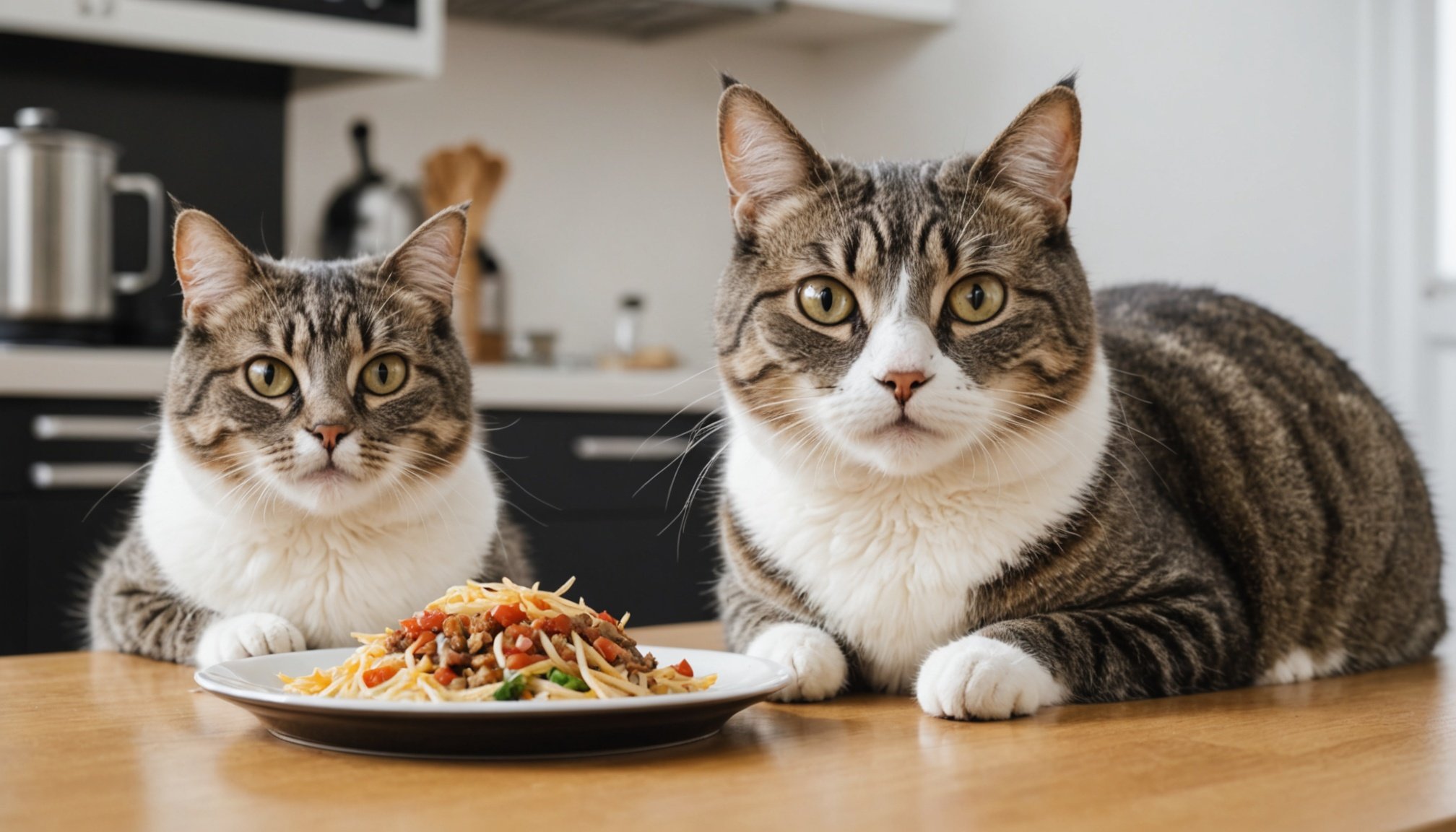Understanding Your Overweight Cat
Recognising signs of obesity in cats is crucial for maintaining feline health. Cats often show weight gain in their ribs and base of the tail, where the extra fat makes it tough to feel bones. A visibly sagging belly or low-hanging apron is another sign. Reduced activity or difficulty jumping can also signal that a cat is overweight. As with humans, obesity in cats can lead to various health risks. The most common risks include diabetes, arthritis, heart problems, and decreased life expectancy. These conditions often arise from excess body weight, stressing organs and joints.
Genetics and lifestyle contribute significantly to a cat’s weight. Some breeds are genetically predisposed to gain weight, making it vital for owners to be vigilant. Sedentary lifestyles, often due to indoor living, can exacerbate weight issues. Cats that lack regular exercise burn fewer calories, leading to weight gain. Owners should ensure their cats receive adequate playtime and stimulation to combat this. Understanding these elements will help owners manage their cats’ weight effectively, preventing obesity and fostering better overall health.
Have you seen this : Ultimate guide to cultivating a flourishing aquarium for your freshwater fish
Nutritional Needs of Overweight Cats
Understanding the specific dietary requirements for overweight cats is essential in fostering feline health. Overweight cats benefit significantly from a diet high in protein and low in carbohydrates. This type of diet helps in promoting lean muscle mass while encouraging fat loss. Essential nutrients include taurine, which supports heart health, and Omega-3 fatty acids for coat maintenance. Regular evaluation of these components is important to ensure balanced nutrition.
When planning a diet, consider factors such as the cat’s age, activity level, and any existing health conditions. Younger cats might require different dietary adjustments compared to senior ones, who may have slower metabolisms. Similarly, active cats might need more energy intake than their less active counterparts.
This might interest you : Creating a purrfect outdoor paradise: your comprehensive guide to designing a safe and engaging space for indoor cats
Additionally, it’s important to recognise how these needs shift as cats age or experience health changes. Consulting with a veterinarian can provide tailored dietary recommendations, ensuring that all nutritional needs are met effectively.
By paying careful attention to these factors, pet owners can support their cats’ weight loss efforts while ensuring they receive the nutrients necessary for comprehensive health. This approach not only aids in weight management but also enhances overall well-being.
Types of Food for Weight Loss
Weight loss cat food plays a pivotal role in managing an overweight cat’s health effectively. Commercial diets crafted for feline weight reduction usually offer balanced nutrition with reduced calorie content and higher fibre to promote satiety. These diets often label their packaging with clear ingredient descriptions, ensuring owners can make informed choices.
Homemade diets, although potentially more personalised, can be challenging to manage accurately. Crafting a diet that includes all necessary nutrients requires careful planning and consultation with a veterinarian. The main advantage is the ability to tailor the diet to specific health needs. However, the major drawback lies in ensuring balanced cat nutrition without professional guidance, which can lead to nutrient deficiencies.
When selecting either commercial or homemade options, evaluating ingredient labels is crucial. Look for high-quality protein sources and minimal fillers. Owners should scrutinise claims regarding “natural” or “premium” ingredients, as these can often be misleading without precise definitions.
-
Benefits of commercial diets:
-
Convenient and nutritionally balanced
-
Easily accessible
-
Pros of homemade diets:
-
Customisable to individual needs
-
Opportunity for fresh ingredient use
Understanding these facets aids in choosing the ideal diet plan tailored to your cat’s needs.
Portion Control Strategies
Proper portion sizes are vital to managing an overweight cat’s diet effectively. Feeding guidelines generally recommend assessing portion sizes based on your cat’s current weight and calorie requirements. These guidelines help ensure that cats receive appropriate nutrition without overfeeding, promoting better long-term feline health.
One crucial aspect of portion control is measuring food accurately. Utilising measuring cups or a kitchen scale can significantly reduce the risk of overfeeding, which is a common issue with free feeding. Measuring tools ensure consistency, allowing pet owners to monitor their cats’ intake precisely.
Another strategy involves the timing of meals. Scheduled feeding differs from free feeding by offering meals at set times, promoting healthy digestion and metabolic rates. This method encourages cats to eat when it is mealtime rather than grazing throughout the day, which can lead to excessive calorie consumption.
Feeding frequency can vary based on individual needs, but typically, two to three smaller meals a day is advantageous for weight management. This approach helps maintain energy levels and prevents hunger that might lead to overeating. By implementing these strategies, owners can effectively regulate their overweight cats’ diets and support their overall health goals.
Creating a Sample Meal Plan
Constructing a structured meal plan is crucial for managing the weight of overweight cats. A well-crafted meal plan focuses on balanced nutrition and caters to specific dietary requirements, ensuring comprehensive cat nutrition.
A weekly meal plan should incorporate a variety of protein sources, such as chicken, turkey, and fish, to maintain interest and meet nutritional needs. Balance these proteins with appropriate portions of fibre-rich vegetables like green beans or peas, which aid digestion and increase satiety. A typical day’s meal setup might include two main meals, with a focus on protein and measured fibre inclusions.
Planning meals in advance can also benefit budgeting and ensure that the desired ingredients are always available. Owners might find buying in bulk and preparing meals ahead of time helps reduce food costs and ensures their cat’s diet remains consistent.
Tips for effective meal prep:
- Use airtight containers for portioning meals, maintaining freshness.
- Rotate protein sources weekly to encourage diverse nutrient intake.
Implementing a carefully considered meal plan caters to an overweight cat’s unique nutritional needs and efficiently supports weight management while enhancing overall feline health.
Monitoring Weight Loss Progress
Monitoring weight loss progress in overweight cats is essential for ensuring long-term feline health. Regularly assessing a cat’s weight and body condition can help owners keep track of improvements and adjust strategies as needed.
Weight tracking involves measuring the cat’s weight consistently, using a reliable scale. This can be done at home or during vet visits. A visual assessment complements this by observing changes in body fat, especially around the ribs and abdomen. Owners should set realistic weight loss goals to guide the process, focusing on gradual progress rather than rapid change to avoid stressing the cat.
Setting timelines helps measure success and keep goals achievable. For example, aiming for a 1-2% weight loss of the cat’s body weight per month is considered safe and effective. It’s imperative to note any plateauing or rapid decrease in weight, as these may signal underlying issues.
Regular vet visits ensure that the weight loss process is monitored professionally, preventing health complications. Vets can provide insights into dietary adjustments or health concerns and make precise calculations on calorie needs, supporting a healthier trajectory for the weight-loss journey.
Potential Health Risks and Considerations
Caring for overweight cats is more than just reducing their portions; it’s essential to be aware of potential health risks. Common weight-related issues include diabetes, arthritis, and cardiovascular diseases. These conditions can be compounded by obesity and stress the cat’s body. For instance, excess weight can lead to insulin resistance, resulting in feline diabetes. Monitoring and maintaining healthy circulation can prevent these diseases from worsening.
It’s crucial to discuss any dietary changes with a veterinarian to ensure that they suit your cat’s individual needs. A veterinarian can provide specific guidance based on the cat’s health condition and dietary requirements. This professional insight ensures that new dietary plans are both effective and safe.
Observing your cat’s behaviour can be instrumental in recognising when to seek veterinary care. Signs such as increased thirst, limping, or changes in appetite might indicate underlying health issues. Consulting with a professional can help address these symptoms promptly and prevent further complications. Being proactive about these weight-related issues ensures your cat stays healthy and enjoys a better quality of life.

